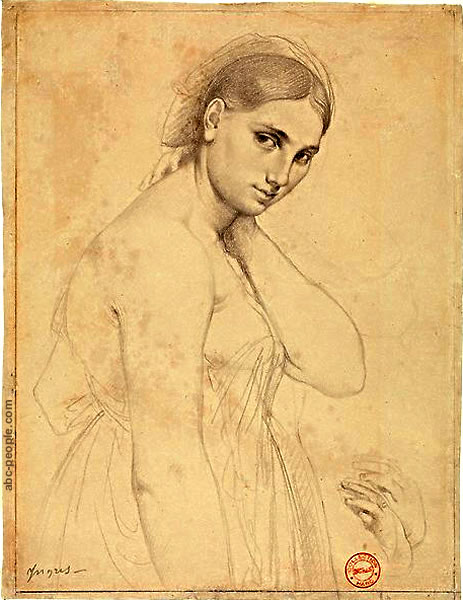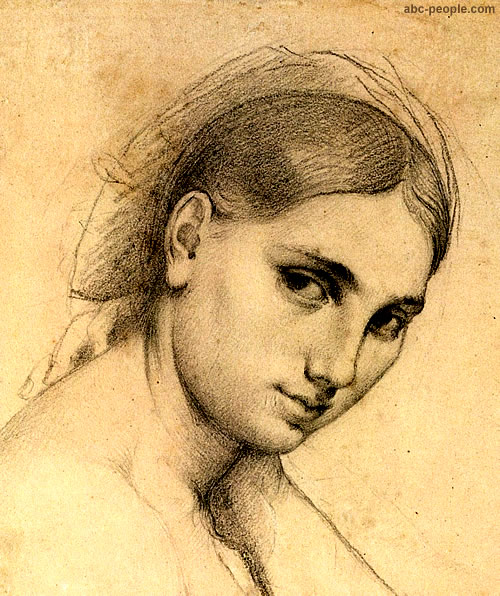| About
Raphael's live |
 |
Raphael
->Main page |
|
Jean
Auguste Dominique Ingres |
|
"Raphael
and La Fornarina" |
Study |
Jean
Auguste Dominique Ingres - Bio |
|
|
|
|
| Raphael
never married, however in 1514 became engaged to Maria Bibbiena,
Cardinal Medici Bibbiena’s niece.
He wasn’t terribly obsessed with this wedding. Maria in the
end died in 1520 as a maiden. |
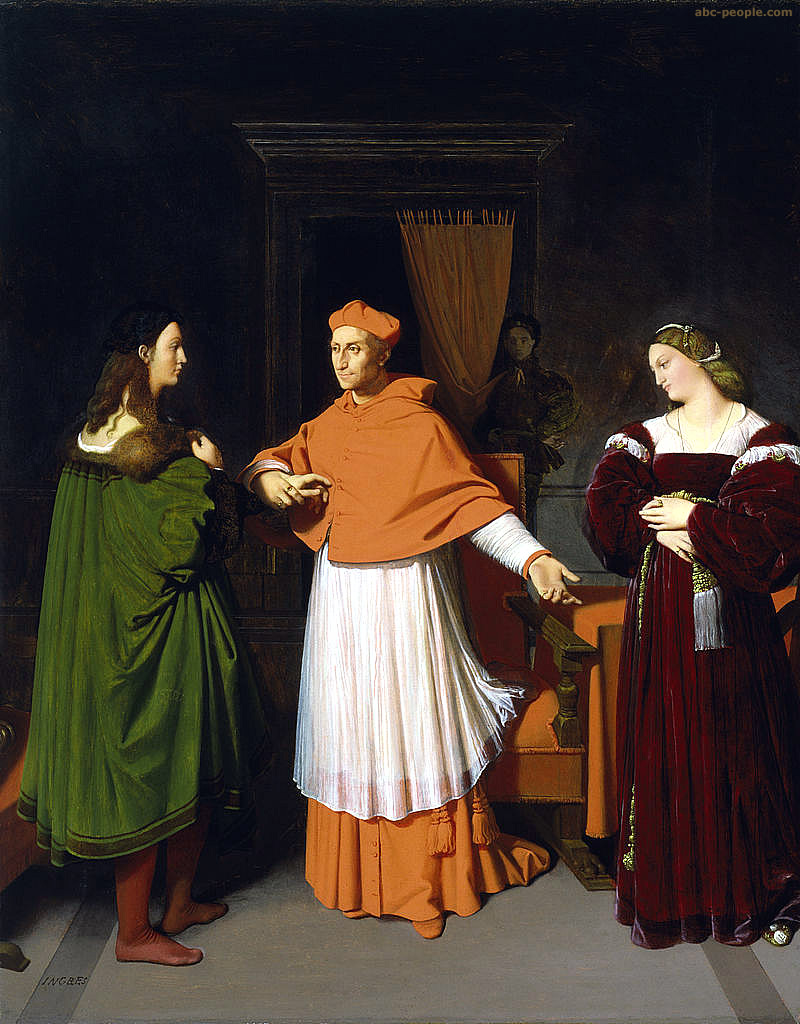
Jean
Auguste Dominique Ingres (1780–1867)
The Betrothal of Raphael and the Niece
of Cardinal Bibbiena
Oil on paper mounted on canvas,
1813-1814
Walters Art Museum, Baltimore
|
| |
Cardinal
Bernardo had a niece, Maria Bibbiena, who wanted to marry
Raphael. The artist felt that he could not refuse, being placed
in a difficult position due to the cardinal’s enormous
influence. Yet it presented him with a problem – because
Raphael was already secretly in love with the daughter of
a baker, Margherita Luti, a woman often referred to as La
Fornarina (the (female) Baker). He accepted the role as Maria
Bibbiena’s fiance, but continually postponed the marriage,
so that it had still not taken place when he died. |
|
|
|
|
| |
"Raphael
and La Fornarina"
is a painting by Jean-Auguste-Dominique Ingres, known in five versions.
The painting belongs to his troubador style period and shows Raphael
and his first love, La Fornarina. Ingres originally planned to produce
a series of paintings of episodes from Raphael's life, but he only
produced two paintings - the other is that of cardinal Bibbiena
offering to marry his niece to Raphael.
Versions:
- 1813, at Riga, disappeared in 1941
- 1814, Fogg Art Museum
- two other versions in private collections
- final version, Columbus Museum of Art
Ingres and the
different paintings he made about Raphael and Fornarina. Raphael gradually
takes on the features of Christ while observing his work, while the
woman, whose gaze points to us, is more and more naked. The third
shows the Transfiguration, one of Raphael's last paintings considered
as his most important work. |
|
|
|
|
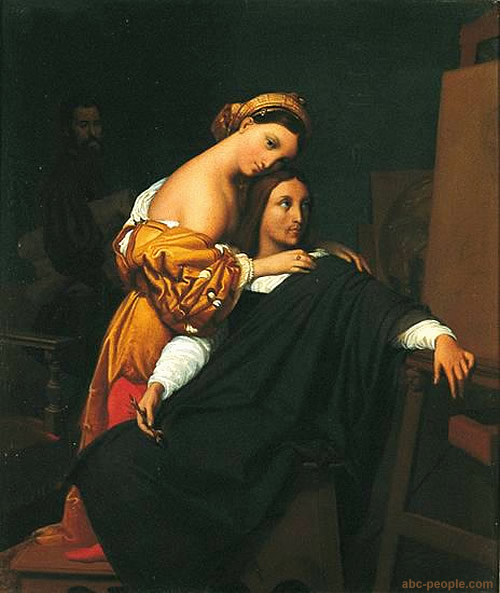
Jean
Auguste Dominique Ingres
Raphael and La Fornarina
Oil
on canvas c. 1827
Kettaneh Collection, New York
|
| |
The
French Neo-Classical master, Jean-Auguste-Dominique Ingres,
who revered Raphael above all other painters, who made the most
famous variations upon the theme of Raphael and his mistress.
In one version, Margherita stands, embracing her lover, while
Michelangelo lurks in the shadows. |
|
|
|
|
|
|
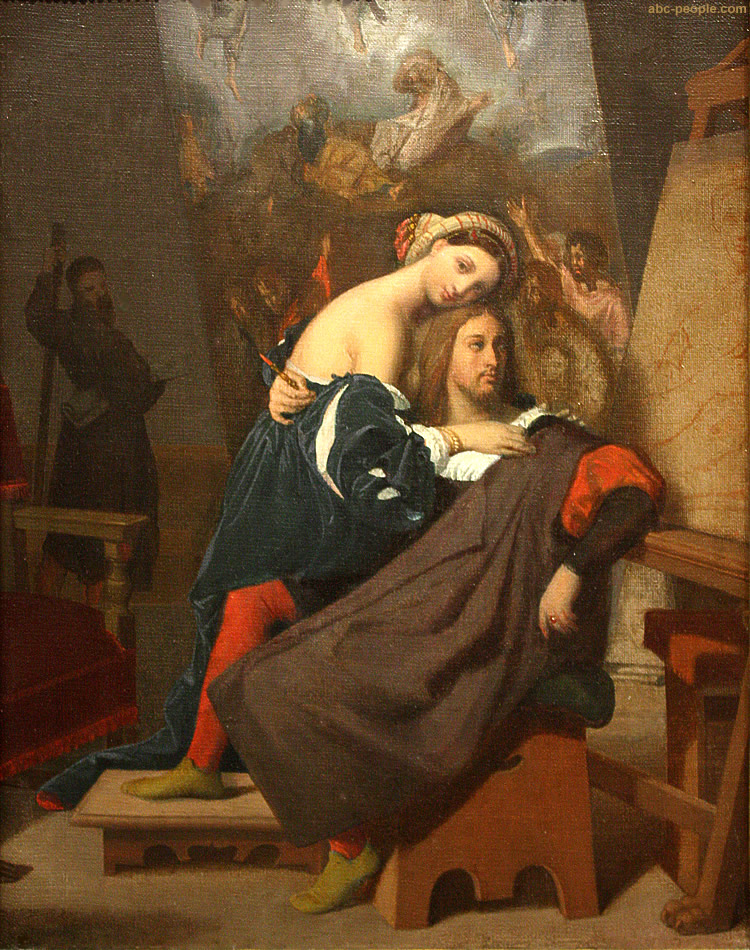 Jean-Auguste-Dominique
Ingres
Jean-Auguste-Dominique
Ingres
Raphael and the Baker's Daughter
Oil
on canvas, 1840, 14 × 10.75 in (35.6 × 27.3 cm)
Columbus Museum of Art |
| |
In
a this variation, Margherita appears to straddle Raphael’s
leg, her robe falling open, while again Michelangelo is seen
in the shadows, beside Raphael’s final masterpiece, The
Transfiguration. |
|
|
|
|
|
| |
|
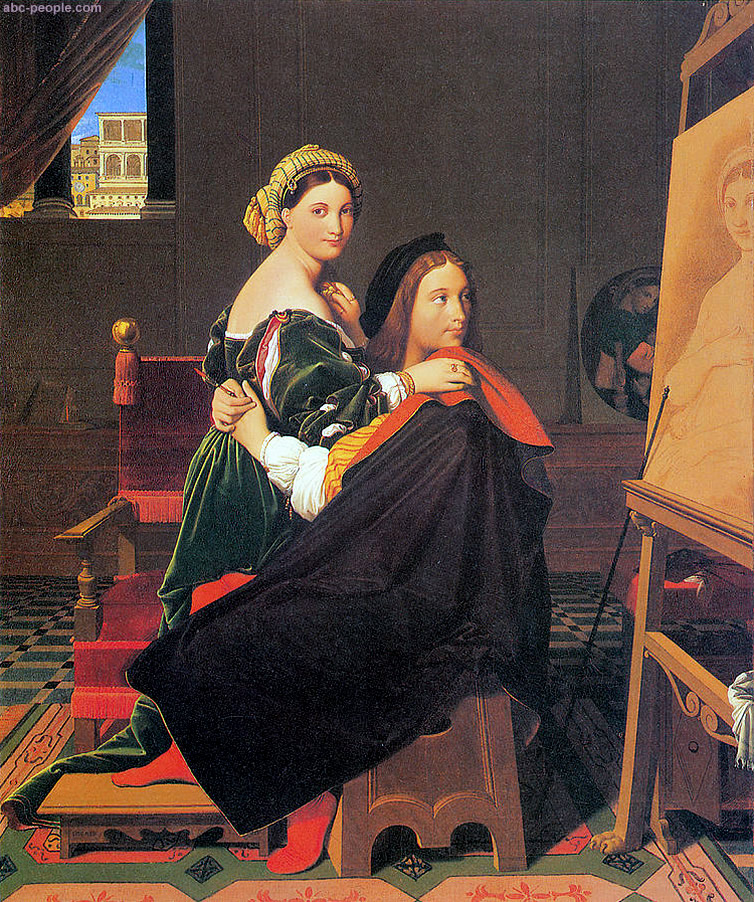
Jean
Auguste Dominique Ingres
Raphael and the Fornarina
Oil on canvas, 1813-1814
Fogg Art Museum, Harvard University, Cambridge
|
| |
In
Ingres’ final version, Margherita sits upon Raphael’s
lap. Her pose and her turban clearly allude to the "Madonna
della seggiola", which can be seen in the background.
On the easel, barely begun, is Raphael’s painting, La
Fornarina. In a manner suggestive of the myth of Pygmalion,
the artist seems torn between Art and “reality”. |
|
|
|
|
|
|
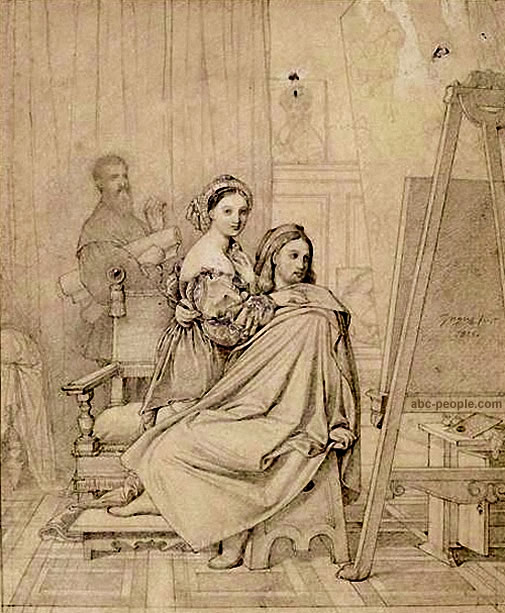
Jean
Auguste Dominique Ingres
Study for "Raphael and the Fornarina"
(Raphaël et la Fornarina)
(sketch)
1825
Louvre Museum, Paris, Department of Graphic Arts
|
| |
This
beguiling drawing relates to "Raphael and La Fornarina",
an issue Jean Auguste Dominique Ingres painted on many occasions.
within the painting, Raphael seems within the studio together
with his legendary mistress-model “La Fornarina”
(the baker’s daughter) sitting on his lap. Ingres, who
greatly loved Raphael, appears to own had Raphael’s love
interest in mind at the terribly moment of his own prayer and
wedding to Madeleine Chapelle. Madeleine has been known because
the model for this study drawn from life. |
|
|
|
| |
| |
Jean
Auguste Dominique Ingres
Study for "Raphael and the Fornarina"
Graphite
on white wove paper, ca. 1814
10 x 7 3/4 in. (25.4 x 19.7 cm)
Robert Lehman Collection
|
|
|
|
| |
| |
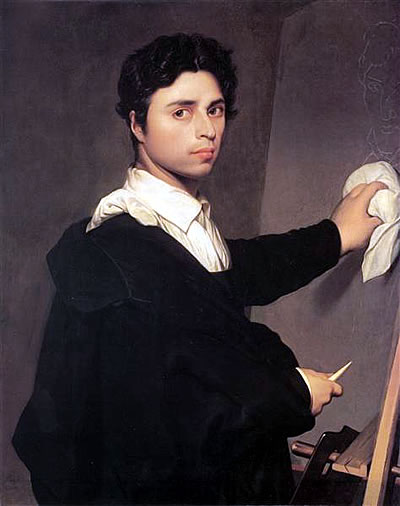 Jean
Auguste Dominique Ingres
Jean
Auguste Dominique Ingres
Self-Portrait
1804. Oil in canvas. Dimensions: 69.9
x 86.4 cm |
Jean-Auguste-Dominique
Ingres
29 August 1780 – 14 January 1867
was
a French Neoclassical painter. Although he considered himself
to be a painter of history in the tradition of Nicolas Poussin
and Jacques-Louis David, by the end of his life it was Ingres's
portraits, both painted and drawn, that were recognized as
his greatest legacy.
Ingres
was profoundly informed by past artistic traditions, and in
his career assumed the role of a guardian of academic orthodoxy
against the ascendant Romantic style, exemplified by Eugène
Delacroix. His expressive distortions of form and space make
him an important precursor of modern art, whose work influenced
Picasso and Matisse and other modernists.
Born
into a modest family in Montauban, he travelled to Paris to
study in the studio of David. In 1802 he made his Salon debut,
and won the Prix de Rome for his painting The Ambassadors
of Agamemnon in the tent of Achilles. By the time he departed
in 1806 for his residency in Rome, his style — revealing
his close study of Italian and Flemish Renaissance masters
was fully developed, and would change little for the rest
of his life.
While
working in Rome and subsequently Florence from 1806 to 1824,
he regularly sent paintings to the Paris Salon, where they
were faulted by critics who found his style bizarre and archaic.
He received few commissions during this period for the history
paintings he aspired to paint, but was able to support himself
and his wife as a portrait painter and draughtsman.
He
finally achieved a great Salon success in 1824 with his Raphaelesque
painting of the Vow of Louis XIII, and became recognized as
the leader of the Neoclassical school in France. Although
commissions for history paintings freed him to paint fewer
portraits, it was his portrait of Louis-François Bertin
that gave him his next popular success in 1833. |
|
| |
The
following year, his indignation at the harsh criticism of his
ambitious composition The Martyrdom of Saint Symphorian caused
him to return to Italy, where he assumed directorship of the
French Academy in Rome in 1835. He returned to Paris for good
in 1841. In his later years he painted new versions of many
of his earlier compositions, a series of designs for stained
glass windows, several important portraits of women, and The
Turkish Bath, the last of his several Orientalist paintings
of the female nude, which he finished at the age of 83. |
|
|
| |
 |
Back
to
Raphael-main page |
|
|
| |
|
| |
|
Copyright
© 2004 abc-people.com
Design and conception BeStudio © 2014-2023 |
|
|
|











